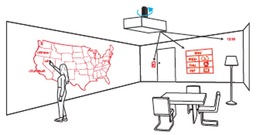UbiChromics: Enabling Ubiquitously Deployable Interactive Displays with Photochromic Paint
TECHNOLOGY NUMBER: 2022-295

OVERVIEW
A photochromic paint which can be used as a display medium- Paint changes color when exposed to different light wavelengths
- Can extend digital content to all display images for many applications
BACKGROUND
Conventional technologies like television screens, video projectors and distributed displays have traditionally been applied to create pervasive and interactive displays. These technologies have played a significant role in various settings, from entertainment venues to commercial spaces and public environments. Television screens have been a staple in households, offering a centralized display for broadcasting content and providing an immersive viewing experience. Video projectors have enabled large-scale projections on screens or surfaces, enabling the creation of cinematic experiences in theaters, conferences, and events. However, traditional display technologies do not scale to room-wide applications due to high per-unit-area costs and the need for constant wired power and data infrastructure. A new category of display promises to present our digital content seamlessly throughout our environment. So, a need exists for pervasive and interactive displays that improve upon limitations of conventional technologies such as high per-unit-area costs, cumbersome deployment methods, and the need for constant wired power and data infrastructure.
INNOVATION
Researchers have discovered a photochromic paint which can be used as a display medium that can be applied to any surface or object to create ultra-low-cost displays. The photochromic material is normally white, and the paint changes color when exposed to specific wavelengths of light. The images and user interfaces can last up to 16 minutes and be updated indefinitely. These new paint formulations can therefore enable a wide area of applications for photochromic materials. Along with a specially modified wide-area laser projector and depth camera that can draw custom images and create on-demand, room-wide user interfaces may exist on photochromic enabled surfaces. System parameters such as light intensity, material activation time, and user readability are examined to optimize the display. Finally, usage scenarios such as displaying static and dynamic images, ephemeral notifications, and the creation of on-demand interfaces such as light switches and music controllers are demonstrated and explored. Ultimately the UbiChromics system demonstrates the possibility of extending digital content to all painted surfaces.